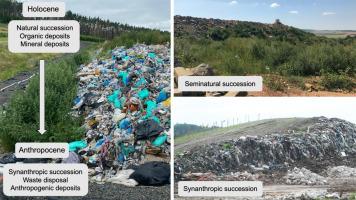Anthropocene ( IF 3.3 ) Pub Date : 2021-06-05 , DOI: 10.1016/j.ancene.2021.100299 Jan Winkler , Eugeniusz Koda , Zdzisław Skutnik , Martin Černý , Dana Adamcová , Anna Podlasek , Magdalena Daria Vaverková

|
The production and management of wastes clearly demonstrates a human influence on the environment. The most frequent method of handling waste worldwide is landfilling, which exerts a range of negative impacts on the environment. This study presents a twenty-year analysis into the vegetation of a closed municipal solid waste landfill in Poland. We assessed the composition of vegetation using the method of phytocoenological relevés. From monitoring 127 plant species, we created a floristic list of species found in the landfill. Detrended Correspondence Analysis enabled establishment of the covers of the plant species detected. Results indicated differences in the representation of native plant species and neophytes in the composition of vegetation. Landfill site environments differed from neighbouring ecosystems after twenty years, a high proportion of invasive neophytes have been identified on the landfill site. These differences suggest that the vegetation in the landfill has been changing, and the spectrum of plant species has been developing over time. Findings indicate that humans not only affect landscapes, but they directly create new ecosystems including geological-pedological layers. Landfills and the whole ecosystem of landfills therefore contain real and clear evidence of human influences on the surface layers of the lithosphere.
中文翻译:

波兰再生垃圾填埋场的同种人类植被演替趋势
废物的生产和管理清楚地表明人类对环境的影响。世界范围内处理废物最常见的方法是填埋,这会对环境产生一系列负面影响。本研究对波兰一个封闭的城市固体垃圾填埋场的植被进行了 20 年的分析。我们使用植物群落学相关方法评估了植被的组成。通过监测 127 种植物物种,我们创建了垃圾填埋场中发现的物种区系列表。去趋势对应分析能够建立检测到的植物物种的覆盖范围。结果表明本地植物物种和新植物在植被组成方面的表现存在差异。二十年后垃圾填埋场环境与邻近生态系统不同,在垃圾填埋场发现了高比例的入侵新手。这些差异表明垃圾填埋场的植被一直在变化,植物物种的范围也在随着时间的推移而发展。研究结果表明,人类不仅影响景观,而且还直接创造新的生态系统,包括地质-土壤层。因此,垃圾填埋场和整个垃圾填埋场生态系统包含人类对岩石圈表层影响的真实而明确的证据。但它们直接创造了新的生态系统,包括地质-土壤层。因此,垃圾填埋场和整个垃圾填埋场生态系统包含人类对岩石圈表层影响的真实而明确的证据。但它们直接创造了新的生态系统,包括地质-土壤层。因此,垃圾填埋场和整个垃圾填埋场生态系统包含人类对岩石圈表层影响的真实而明确的证据。











































 京公网安备 11010802027423号
京公网安备 11010802027423号